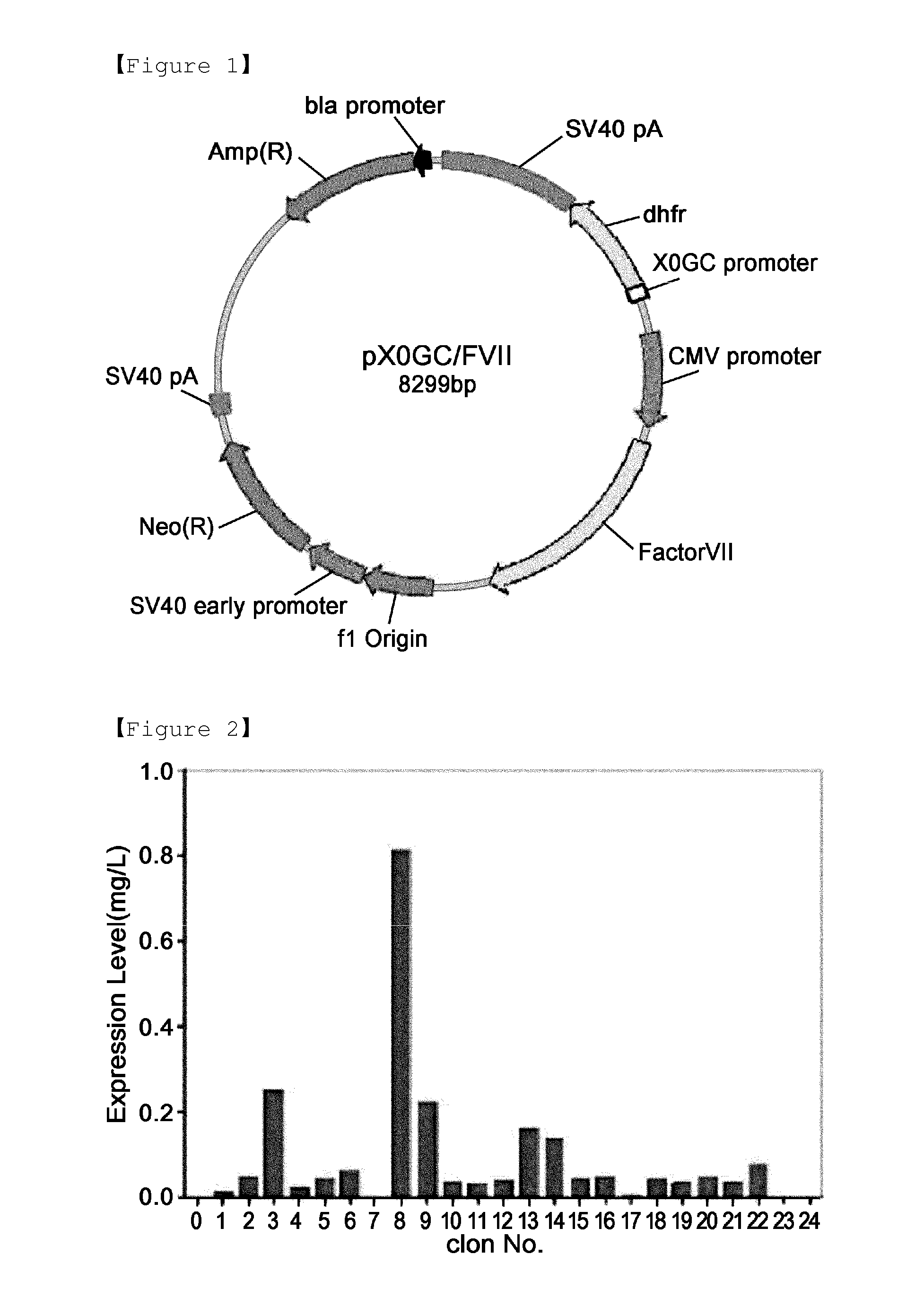Method for mass production of factor vii/viia
a technology of coagulation factor and mass production, which is applied in the field of mass production of human coagulation factor vii, can solve the problems of low production yield of plasma-derived factor viia, low productivity, and inability to guarantee low productivity, etc., and achieves high efficiency
- Summary
- Abstract
- Description
- Claims
- Application Information
AI Technical Summary
Benefits of technology
Problems solved by technology
Method used
Image
Examples
example 1
Construction of Expression Vector (pX0GC-FVII) for Recombinant Factor VII
[0051] Amplification of Factor VII
[0052]For use in inducing the overexpression of recombinant factor VII in animal cells, an expression vector was constructed. A human factor VII gene containing a signal sequence was obtained using PCR (polymerase chain reaction). The amplification of a factor VII gene was performed using forward and reverse primers of SEQ ID NOS: 1 and 2, with the human fetal liver cDNA library (purchased from Clontech USA, now incorporated into TAKARA BIO USA) serving as a template. For the convenience of cloning, the forward and the reverse primer were designed to have BamHI and XhoI restriction enzyme sites, respectively. These primers are given in Table 1, below.
TABLE 1Primers for Amplifying Human Factor VII GeneFactorSEQVIIIDPrimerBase SequenceNOForwardCccggatccatggtctcccaggccctcaggctcc1(VIIBHISS)Reversegggctcgagctagggaaatggggctcgcagg2(VIIXhoIAS)
[0053]A mixture comprising the cDNA library...
example 2
Establishment of Human Factor VII Expressing Cell Line
[0057] Transformation of Cell Line
[0058]To prepare a new cell line which can produce human factor VII on a mass scale, the recombinant human factor VII expression vector (pX0GC-FVII), constructed in Example 1 was introduced into the CHO cell line which showed unstable DNA synthesis due to the deficiency of DHFR (CHO / dhfr-) (Urlaub et al., Somat. Cell. Mol. Genet., 12, 555-566, 1986). In this regard, DG44-CHO (dhfr deficient) cells (obtained from Dr. Chasin, Columbia University) were cultured in T75 flasks and when grown to 80-90 confluence, the cells were transfected using Lipofectamine (Gibco, Cat. No. 18324-012). In each of two tubes was placed 3 mL of Opti-MEM (Gibco, Cat. No. 51985034). Then, the two tubes received 5 μg of DNA and 20 μl of Lipofectamine, respectively and were left to stand for 30 min. These two solutions were mixed together, and the DNA-Lipofectamine complex thus formed was dropped onto the cells which were p...
example 3
Growth of the Cell Line in the Presence of Sodium Butyrate and Measurement of hVII Level (1)
[0062] Seed and Main Culture
[0063]One vial (1×107 cells / mL) of the hFVII-expressing cell line which had been selected and assimilated to a suspension culture in Example was taken from a liquid nitrogen tank and thawed as soon as possible in a 37° C. bath. After being washed once with a seed culturing medium (EX-CELL CHO medium (Sigma, Cat. No. 63225C) supplemented with 0.3 g / L glutamine), the cell culture was centrifuged at 90×g for 5 min and then inoculated into 50 mL of a seed culture medium in an Erlenmeyer flask (Corning, USA cat#431144). When grown for 1-2 days to a density of 10×105 cells / mL in a CO2 incubator (37° C., 5% CO2), the cells were centrifuged again in the same manner and then sub-cultured in 100 mL of a fresh seed culture medium in a new Erlenmeyer flask. The double-volume passage was continued until there was a sufficient number of cells.
[0064] Growth of the Cell Line in P...
PUM
| Property | Measurement | Unit |
|---|---|---|
| molecular weight | aaaaa | aaaaa |
| concentration | aaaaa | aaaaa |
| pH | aaaaa | aaaaa |
Abstract
Description
Claims
Application Information
 Login to View More
Login to View More - R&D
- Intellectual Property
- Life Sciences
- Materials
- Tech Scout
- Unparalleled Data Quality
- Higher Quality Content
- 60% Fewer Hallucinations
Browse by: Latest US Patents, China's latest patents, Technical Efficacy Thesaurus, Application Domain, Technology Topic, Popular Technical Reports.
© 2025 PatSnap. All rights reserved.Legal|Privacy policy|Modern Slavery Act Transparency Statement|Sitemap|About US| Contact US: help@patsnap.com

